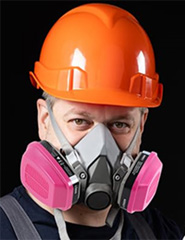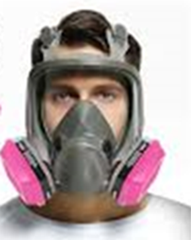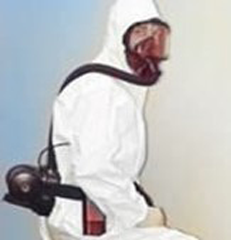Respiratory Protection Requirements During Fire Cleanup, Removal and Demolition
After fires are extinguished and the smoke has cleared, employees may be exposed to hazardous air contaminants when cleaning, removing or demolishing fire-damaged structures, vehicles, and other debris. Burning of electronics, appliances, home décor, paint, plastics and other household and commercial products releases toxic air contaminants and produces hazardous compounds that are often present in ash, soot, and debris. Employers must protect employees from exposure to these hazardous substances during cleanup, removal, demolition, and related work.
The health effects of inhaling hazardous substances in ash and debris can vary depending on how much is inhaled, for how long, and in what combination. Ash and debris from fires involving structures, vehicles, and other synthetic materials is toxic. It typically includes the following toxic substances, which can be inhaled by employees when ash and debris are disturbed:
Particles. When inhaled, fine particles are capable of penetrating deeply into the areas of the lung where gas exchange occurs. Studies have consistently shown that this can result in a range of health problems, including nonfatal heart attacks, irregular heartbeat, asthma aggravation, decreased lung function, airway irritation, coughing, difficulty breathing, and premature death in people with preexisting heart or lung disease.1 Among firefighters, exposure to fine particles has been proposed as a contributing factor to sudden cardiac death and other health effects.2,3
Asbestos. Structures that were built before 1981 usually contain asbestos, which was widely used in tiles, cement, roof shingles, insulation and other products. Asbestos fibers are not destroyed by fire. Inhaling asbestos fibers is associated with various types of cancer and is the cause of mesothelioma, a cancer of the lining of the chest and abdomen.4,5,6
Heavy metals. Structure fire ash and debris typically contains trace amounts of lead, cadmium, chromium, mercury, copper, manganese, nickel, arsenic, zinc, iron, and aluminum (CDPH 2019). Exposure to these toxic metals can cause a range of health effects, including nervous system disorders, gastrointestinal and kidney dysfunction, skin lesions, vascular damage, immune system dysfunction, birth defects and cancer.7,8
Polycyclic aromatic hydrocarbons (PAHs), polychlorinated biphenyls (PCBs), dioxins, and furans. These hazardous air contaminants are present at the site of structure fires, even several days after the fire has been extinguished. Exposure to PAHs is associated with breast cancer, childhood cancers and lung cancer, as well as reduced lung function, asthma exacerbation, and increased rates of obstructive lung diseases and cardiovascular diseases.9,10,11,12
Volatile organic compounds (VOCs). Studies have shown that benzene and 1,3-butadiene are emitted into the air many days after a structure fire has been extinguished. Exposure to these chemicals is associated with various types of blood cancer.13,14
Formaldehyde. Ash and debris from structure fires emits formaldehyde for at least five days after the fire has been extinguished (Horn figure 6). Formaldehyde is a known human carcinogen that can cause leukemia and cancers of the nose, throat, and sinuses.16,17
Coccidioides in soil. Inhaling the spores of this soil fungus can result in Valley fever, an infection of the lungs that can cause fatigue, cough, difficulty breathing, fever, night sweats, muscle or joint pain, chest pain, weight loss, headache, and rash. If Valley fever infects the brain (called meningitis), the employee will probably require lifelong treatment. In very rare cases, severe Valley fever can be fatal.18
Gases. Carbon monoxide (CO) is a colorless and odorless gas that is released from gas and diesel-powered equipment. Low-level exposure causes headache, nausea, dizziness and other symptoms; at higher levels, it can result in neurological damage that doesn't heal; damage to the heart, possibly leading to life-threatening heart problems; and death. Gas and diesel-powered equipment must never be used in enclosed or semi-enclosed spaces.19
Using Ventilation and Water to Reduce Exposures
Employee exposures to hazardous air contaminants should be minimized by ventilating the area before and during work. At fire cleanup, removal and demolition sites, employers must also provide a water supply sufficient for employees to effectively suppress dust from ash, debris, and dirt (T8CCR 5141(a) and 1532.3(c)(2)). Ventilation and the use of water reduces inhalation exposures to particles, asbestos, heavy metals, PAHs, VOCs, formaldehyde and Coccidioides spores and will improve the effectiveness of respirators and the employer's respiratory protection program, described below (T8CCR 5144).
Vacuums used to clean up dust, ash, soot, and other must be equipped with high-efficiency air purifying (HEPA) filters. Dry sweeping and the use of powered blowers at fire cleanup, removal, and demolition sites is not allowed.
Respiratory Protection Program
Employers must comply with Cal/OSHA's respiratory protection standard (T8CCR 5144) and provide NIOSH-approved respiratory protection to employees who enter areas to perform clean-up, removal, demolition, or related activities where structures, vehicles or other synthetic materials have burned. Employers must develop and implement a written respiratory protection program that includes the following:
- Procedures for selecting the correct respirator
- Medical evaluations of employees who use respirators
- Annual respirator fit testing of employees
- Procedures for proper use, maintenance, cleaning and replacement of respirators
- A cartridge change-out schedule to ensure that cartridges are replaced before the end of their service life, unless the cartridge has an end-of-service-life indicator.
- Training of employees on the respiratory hazards in burned areas, and on the limitations and proper use of respirators
WARNING: Providing employees with respirators that are not protective against the hazards present in the work area is a violation of California Code of Regulations, Title 8, section 5144) and endangers the health and safety of employees.
Hazard Evaluation
Before employees enter a work area that could contain hazardous air contaminants, T8CCR 5144 requires the employer to identify and evaluate the chemical and physical properties of any hazardous air contaminants that may be present and reasonably estimate employee exposure levels.
Where it is not possible to identify hazardous air contaminants or reasonably estimate employee exposures, employers must consider the atmosphere to be immediately dangerous to life and health (IDLH). Under 8CCR 5144, IDLH means an “atmosphere that poses an immediate threat to life, would cause irreversible adverse health effects, or would impair an individual's ability to escape from a dangerous atmosphere.” The atmosphere must also be considered IDLH if it could contain insufficient oxygen; if it contains very high concentrations of air contaminants; if the concentration of air contaminants exceeds the capacity of air-purifying respirators (APRs); or if APRs are not able to effectively protect against the particular air contaminants present in the space.
Under 8CCR 5144, IDLH atmospheres require use of a NIOSH-certified, self-contained breathing apparatus (SCBA) with a minimum service life of thirty minutes, or a full facepiece, supplied-air respirator (SAR) with auxiliary self-contained air supply. An SCBA provides air from a compressed cylinder carried by the user. The assigned protection factor (APF) for an SCBA ranges from 10 to 10,000. Supplied-air respirators provide air through an airline hose from a source outside the contaminated work area. The APF for a supplied air respirator ranges from 10 to 1,000. An APF of greater than 100 may only be applied when quantitative fit testing is used to assess the respirator fit on the user.
Fire Cleanup, Removal and Demolition
The great majority of outdoor sites where employees perform fire cleanup, removal and demolition work are unlikely to be IDLH. In these cases, following the employer's evaluation of potential IDLH conditions, the employer must provide employees with an elastomeric air-purifying respirator (APR) equipped with a high-efficiency particulate air (HEPA) filter, combined with an organic vapor (OV) and formaldehyde cartridge (T8CCR 5144). A P100, N100 or R100 filter may be used in lieu of a HEPA filter.
Half-facepiece respirators have an APF of 10. Full facepiece respirators have an APF of 50 and also protect the eyes from dust, debris, and chemical substances.
Both half and full-facepiece respirators are available in models equipped with battery-operated fans that make them cooler and less difficult to breathe through, known as powered air-purifying respirators (PAPRs). The APF is 50 for a half-facepiece PAPR and 100 to 1000 for a full-facepiece PAPR.
Both full and half-facepiece APRs and PAPRs that are equipped with a HEPA filter and OV-formaldehyde cartridge as noted above are permissible for use by employees who perform cleanup, removal, demolition and related work in burned areas.



With half-mask and full facepiece APRs, employees should check for proper function by performing a basic seal check before each use, as follows:
- First, cover the filter/cartridge ensemble and breathe in. The mask should pull up against the user's face.
- Second, cover the exhalation valve(s) on the mask and exhale lightly. There should be no significant leakage and the respirator should push away slightly from the user's face.
For all respirator types, employers must ensure that employees do not allow hair, eyeglasses, or other objects to interfere with the seal of the respirator to the face. Employees must be clean-shaven where the seal contacts the face for the respirator to seal properly.
WARNING: APRs and PAPRs do not provide oxygen and do not protect the wearer against carbon monoxide (CO). Employers should ensure that APRs and PAPRs are never used in areas that may be oxygen-deficient; in confined spaces, particularly where CO or hazardous gases or chemicals may be present; or when working near large chemical spills.
To avoid counterfeit respiratory protection products, please visit the NIOSH Certified Equipment List.
Use of N95 Respirators
Employers may provide a disposable filtering facepiece respirator (N95) to employees in areas where vegetation or untreated wood alone has burned, in lieu of the elastomeric APR noted above. P95 and R95 versions are also available, which are more resistant to oil mists. An N100, P100 or R100 may be used in lieu of an N95, P95 or R95.
Disposable filtering facepiece respirators may also be used by employees for cleaning unburned, undamaged structures in areas adjacent to areas where structures have burned. However, if smoke odors are detected on the interior of the structure where employees will be working, the employer should provide employees with an elastomeric air-purifying respirator (APR) equipped with a high-efficiency particulate air (HEPA) filter, combined with an organic vapor (OV) and formaldehyde cartridge (T8CCR 5144), as noted above. A P100, N100 or R100 filter may be used in lieu of a HEPA filter.
When using a filtering facepiece respirator, employees must use both straps, one around the back of the neck and the other around the crown of the head. Using a single strap does not allow the respirator to maintain a proper seal.
For instructions on using filtering facepieces, see "Using Disposable Respirators" in English and Spanish.
Bandanas, surgical masks, and other unapproved masks with a single strap or ear loops do not protect against hazardous air contaminants encountered at fire cleanup, removal and demolition sites. Providing these types of masks to employees, or allowing their use, is a violation of T8CCR 5144.
KN95s and other types of unapproved masks that are marketed as respirators do not protect workers and are not allowed as respiratory protection
Voluntary Use
Where respirator use is not required by Cal/OSHA regulations or by the employer, the employer may provide respirators at the request of employees for voluntary use, or may permit employees to use their own N95 or other filtering facepiece respirator, if the employer determines that such respirator use will not in itself create a hazard. The employer must provide respirator users with the information contained in Appendix D to 8CCR section 5144 and must follow the requirements of section 5144(c)(2).
Resources
- Cal/OSHA Publication: Respiratory Protection in the Workplace: A Practical Guide for Small-Business Employers
- Cal/OSHA Respiratory Protection standard: California Code of Regulations, Title 8, section 5144
- Federal Occupational Safety and Health Administration (OSHA) webpage on respiratory protection
- National Institute for Occupational Safety and Health (NIOSH) webpage on respirators
1U.S. Environmental Protection Agency. Health and Environmental Effects of Particulate Matter (PM). Published July 2024.
2Smith D, DeBlois J, Kales S, Horn G. 2016. Cardiovascular Strain of Firefighting and the Risk of Sudden Cardiac Events. Exerc. Sport Sci. Rev. 44(3):90⋏97. [PubMed: 27111479] Baxter et al. 2010; Smith, Barr & Kales, 2013 Smith et al. 2016. Horn p 10.
3Smith DL, Barr DA, Kales SN. 2013. Extreme sacrifice: sudden cardiac death in the US Fire Service. Extrem. Physiol. Med. 2:6. [PubMed: 23849605]
4California Department of Public Health. Wildfire Cleanup: Considerations for California's Public Health Officials. Published August 2019 (p. 2).
5Whitmer M, Pacheco W, Shukla A. Asbestos and Natural Disasters Guide. Published December 2024.
6U.S. Occupational Safety and Health Administration (OSHA). Asbestos. Published date not listed.
7California Department of Public Health, op cit. (pp. 2-4)
8Balali-Mood M, Naseri K, Tahergorabi Z, Khazdair MR, Sadeghi M. 2021. Toxic Mechanisms of Five Heavy Metals: Mercury, Lead, Chromium, Cadmium, and Arsenic. Front Pharmacol Apr 13;12:643972.
9California Department of Public Health, op cit. (pp. 2-4).
10Sjöström M, Julander A, Strandberg B, Lewné M, Bigert C. 2019. Airborne and Dermal Exposure to Polycyclic Aromatic Hydrocarbons, Volatile Organic Compounds, and Particles among Firefighters and Police Investigators. Annals of Work Exposures and Health, Vol. 63, No. 5, 533⋏545.
11Geosyntec. Assessment of Burn Debris -2015 Wildfires Lake and Calaveras Counties, California. Published December 2015.
12World Health Organization. Human health effects of polycyclic aromatic hydrocarbons as ambient air pollutants - Report of the Working Group on Polycyclic Aromatic Hydrocarbons of the Joint Task Force on the Health Aspects of Air Pollution. Published November 2021.
13Sjöström M, Julander A, Strandberg B, Lewné M, Bigert C. 2019. Airborne and Dermal Exposure to Polycyclic Aromatic Hydrocarbons, Volatile Organic Compounds, and Particles among Firefighters and Police Investigators. Annals of Work Exposures and Health, Vol. 63, No. 5, 533⋏545.
14Chen W-Q, Xin-Yu Zhang X-Y. 1,3-Butadiene: a ubiquitous environmental mutagen and its associations with diseases. Genes and Environment. 2022. 44:3
15Horn G, Madrzykowski D, Neumann D, Mayer A, Fent K. 2022. Airborne contamination during post-fire investigations: hot, warm & cold scenes. J Occup Environ Hyg. January; 19(1): 35⋏49.
16California Environmental Protection Agency (Cal/EPA), Office of Environmental Health Hazard Assessment (OEHHA): Formaldehyde. Published June 2021.
17California Environmental Protection Agency (Cal/EPA), Office of Environmental Health Hazard Assessment (OEHHA): Acute, 8-hour and Chronic Reference Exposure Level (REL) Summary. Formaldehyde. Published October 2023.
18California Department of Public Health. Valley fever. Published July 2024.
19Mayo Clinic. Carbon Monoxide Poisoning. Published April 2023.
February 2025

